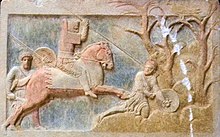
Xerxes I, commonly known as Xerxes the Great, was a Persian ruler who served as the fourth King of Kings of the Achaemenid Empire, reigning from 486 BC until his assassination in 465 BC. He was the son of Darius the Great and Atossa, a daughter of Cyrus the Great. In Western history, Xerxes is best known for his invasion of Greece in 480 BC, which ended in Persian defeat. Xerxes was designated successor by Darius over his elder brother Artobazan and inherited a large, multi-ethnic empire upon his father's death. He consolidated his power by crushing revolts in Egypt and Babylon, and renewed his father's campaign to subjugate Greece and punish Athens and its allies for their interference in the Ionian Revolt. In 480 BC, Xerxes personally led a large army and crossed the Hellespont into Europe. He achieved victories at Thermopylae and Artemisium before capturing and razing Athens. His forces gained control of mainland Greece north of the Isthmus of Corinth until their defeat at the Battle of Salamis. Fearing that the Greeks might trap him in Europe, Xerxes retreated with the greater part of his army back to Asia, leaving behind Mardonius to continue his campaign. Mardonius was defeated at Plataea the following year, effectively ending the Persian invasion.

Darius III was the thirteenth and last Achaemenid King of Kings of Persia, reigning from 336 BC to his death in 330 BC.

Tissaphernes was a Persian commander and statesman, Satrap of Lydia and Ionia. His life is mostly known from the works of Thucydides and Xenophon. According to Ctesias, he was the son of Hidarnes III and therefore, the great grandson of Hydarnes, one of the six conspirators who had supported the rise of Darius the Great.

Bessus or Bessos, also known by his throne name Artaxerxes V, was a Persian satrap of the eastern Achaemenid satrapy of Bactria, as well as the self-proclaimed King of Kings of the Achaemenid Empire from 330 to 329 BC.
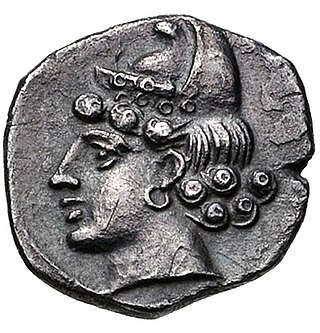
Arses, also known by his regnal name Artaxerxes IV, was the twelfth Achaemenid King of Kings from 338 to 336 BC.
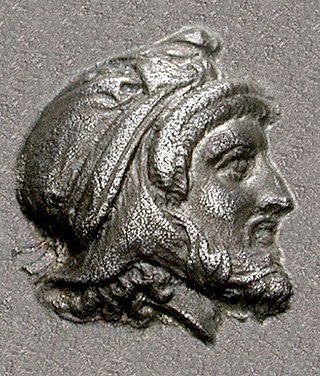
Pharnabazus II was a Persian soldier and statesman, and Satrap of Hellespontine Phrygia. He was the son of Pharnaces II of Phrygia and grandson of Pharnabazus I, and great-grandson of Artabazus I. He and his male ancestors, forming the Pharnacid dynasty, had governed the satrapy of Hellespontine Phrygia from its headquarters at Dascylium since 478 BC. He married Apama, daughter of Artaxerxes II of Persia, and their son Artabazus also became a satrap of Phrygia. According to some accounts, his granddaughter Barsine may have become Alexander the Great's concubine.

Ochus, known by his dynastic name Artaxerxes III, was King of Kings of the Achaemenid Empire from 359/58 to 338 BC. He was the son and successor of Artaxerxes II and his mother was Stateira.
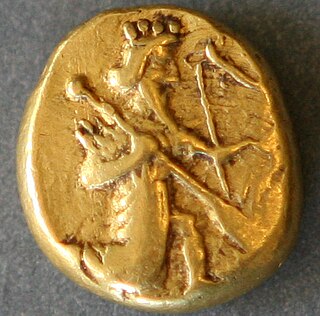
The daric was a gold coin which, along with a similar silver coin, the siglos, represented the bimetallic monetary standard of the Achaemenid Empire.
Hydarnes, also known as Hydarnes the Elder, was a Persian nobleman, who was one of the seven conspirators who overthrew the Pseudo-Smerdis. His name is the Greek transliteration of the Old Persian name Vidṛna, which may have meant "he who knows the guilt/wrong".

Datames, also known as Tarkamuwa, was an Iranian military leader, who served as the governor (satrap) of the Achaemenid satrapy of Cappadocia from the 380s BC to 362 BC. A Carian by birth, he was the son of Camissares by a Paphlagonian mother. His father being satrap of Cilicia under Artaxerxes II, and high in the favour of that monarch, Datames became one of the king's bodyguards; and having in this capacity distinguished himself in the war against the Cadusii, was appointed to succeed his father in the government of his province. Here he distinguished himself both by his military abilities and his zeal in the service of the king; and reduced to subjection two officials who had revolted from Artaxerxes, Thyus, governor of Paphlagonia, and Aspis of Cataonia.

The Cadusii were an ancient Iranian tribe that lived in the mountains between Media and the shore of the Caspian Sea, an area bordering that of the Anariacae and Albani. The Dareitai and Pantimati people may have been part of the Cadusii.
Parysatis was a Persian queen, consort of Darius II and had a large influence during the reign of Artaxerxes II.
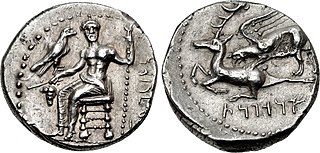
Ariarathes I was the last Achaemenid Persian governor (satrap) of the province (satrapy) of Northern Cappadocia, serving from the 340s BC to 331 BC. He led defensive efforts against the Macedonian invasion, commanded by Alexander the Great, and later fought at the Battle of Gaugamela under Darius III, the last King of Kings of the Achaemenid Empire. After the fall of the Achaemenid Empire, Ariarathes continued his resistance against the Macedonians, ruling concomitantly as an Achaemenid remnant and a precursor to the Kingdom of Cappadocia. He is regarded as the founder of the Iranian Ariarathid dynasty.

Tiribazus, Tiribazos or Teribazus was an Achaemenid satrap of Armenia and later satrap of Lydia in western Anatolia.

Pharnabazus III was a Persian satrap who fought against Alexander the Great. His father was Artabazos II, and his mother a Greek from Rhodes.

Arsames was an Achaemenid satrap of ancient Egypt during the 5th century BC, at the time of the 27th Dynasty of Egypt.

The Achaemenid Empire or Achaemenian Empire, also known as the Persian Empire or First Persian Empire, was an Iranian empire founded by Cyrus the Great of the Achaemenid dynasty in 550 BC. Based in modern-day Iran, it was the largest empire by that point in history, spanning a total of 5.5 million square kilometres. The empire spanned from the Balkans and Egypt in the west, West Asia as the base, the majority of Central Asia to the northeast, and the Indus Valley to the southeast.

Orontes I was a military officer of the Achaemenid Empire and satrap of Armenia at the end of the 5th-century BC and first half of the 4th-century BC. He is notable for having led the unsuccessful Great Satraps' Revolt in Asia Minor against the Achaemenids from 362/1 BC to 360/359 BC.
Artasyrus was a Bactrian nobleman in the Achaemenid Empire, who was the father of Orontes I, the satrap of the Armenia and ancestor of the Orontid dynasty. The career of Artasyrus is obscure. According to the Greek historian Plutarch, he held the high-ranking office of the "King's Eye". He has been suggested be the same person as the namesake Iranian noble who participated in the Battle of Cunaxa in 401 BC. He and Orontes I are the only Bactrians who are known to have occupied high offices under the Achaemenid Empire. Bactrians that settled in other parts of the empire either did so by their own will or as garrison-colonists.
Hydarnes II, also known as Hydarnes the Younger was a Persian commander of the Achaemenid Empire in the 5th century BC. He was the son of Hydarnes, satrap of the Persian empire and one of the seven conspirators against Gaumata.


